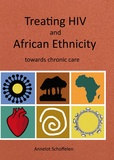Treating HIV and African ethnicity
Towards chronic care

Schoffelen, Annelot
- Promoter:
- Prof.dr. I.M. (Andy) Hoepelman
- Co-promoter:
- Dr. R.E. (Roos) Barth
- Research group:
- Hoepelman
- Date:
- July 7, 2015
- Time:
- 10:30 h
Summary
Since the introduction of antiretroviral therapy (ART) almost two decades ago, the course of an HIV infection has shifted from acute illness with high mortality towards a chronic disease with good life expectancy. Alongside the improved survival, new comorbidities have emerged as well amongst the group of patients that is living with chronic HIV. Until now, most research on long-term comorbidities in this population has been performed among Western patients in Europe and the United States. Relatively little is known about the long-term effects of HIV in people with African ethnicity, while the majority of the worldwide HIV population resides in Sub-Saharan Africa (SSA). The course of an HIV infection may be different among people of African ethnicity compared with Western populations. This thesis aimed to address some aspects of treating HIV and African origin, both looking at the role of African ethnicity within a Western country such as the Netherlands, and studying some long-term effects of HIV in a rural area in South Africa. In part 1, we looked into the role of genetic diversity by comparing individuals from African origin with people originating from Western European countries within the Dutch HIV population. We made use of the observational AIDS Therapy Evaluation in the Netherlands (ATHENA) cohort. We investigated the occurrence of Pneumocystis jirovecii pneumonia (PJP), a frequently diagnosed opportunistic infection among HIV-infected people. Moreover, we studied the role of African ethnicity as a risk for chronic kidney disease (CKD) in HIV in the current treatment era. The results showed that host factors such as genetic variability play a role in the occurrence of opportunistic infections and long-term complications such as CKD. Knowledge on the potential effects of a different genetic makeup in people of African ancestry will contribute to improved HIV care. For the second part of the thesis, treatment of HIV infection and some of its associated long-term complications were studied in SSA. The setting of the research was Elandsdoorn, a township situated in a poor, rural area in Limpopo, a province in the northeast of South Africa. The results of a study looking into the efficacy of second-line ART show that good long-term clinical and virological outcomes following first-line failure can be achieved. On-going evaluation of the efficacy of ART is warranted. In addition, we performed a cross-sectional observational study focusing on renal and cardiovascular disease to have a look into the prevalence of non-communicable diseases (NCDs) in HIV infection. Over 900 patients were screened. Albuminuria and atherosclerotic disease were observed in a substantial proportion of the study population, and were associated with traditional lifestyle-related risk factors. On the other hand, HIV determinants were not related to subclinical atherosclerosis. Prevention and treatment of cardiovascular risk factors are not routinely implemented in the current health service delivery in SSA, while the burden of NCDs is only expected to increase. Continuity care models integrating HIV and NCD care can be a solution. This requires a reorganization of financial resources and is a major challenge for the near future.